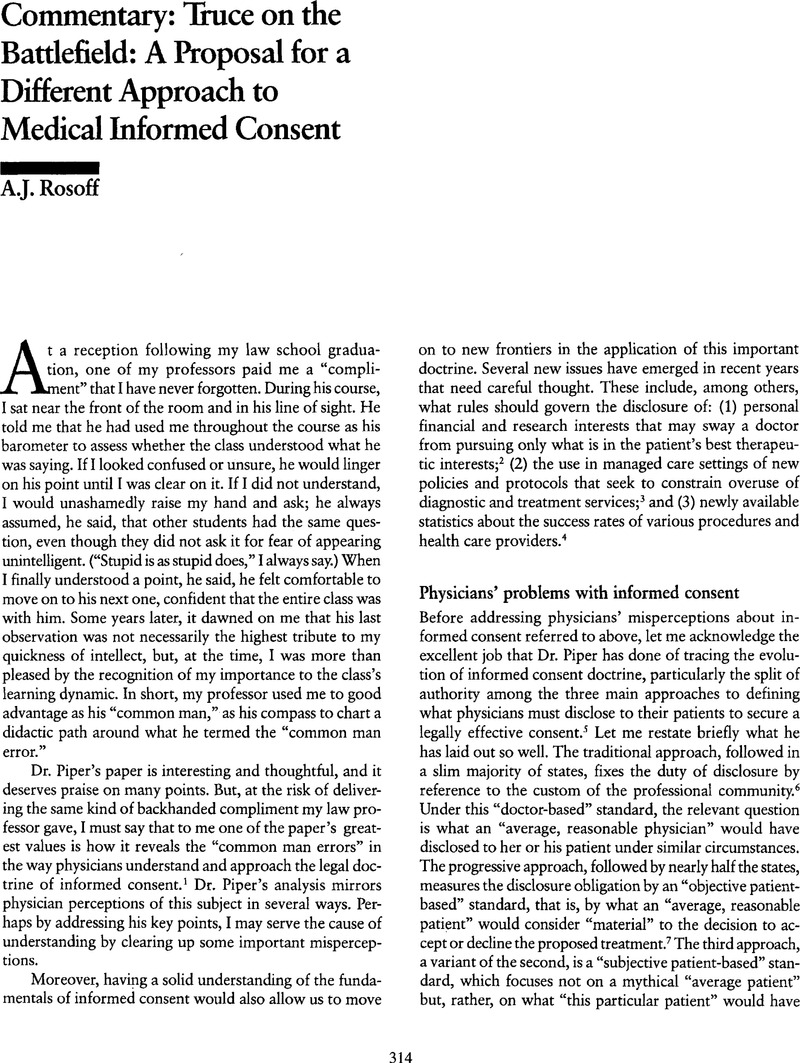No CrossRef data available.
Article contents
Commentary: Truce on the Battlefield: A Proposal for a Different Approach to Medical Informed Consent
Published online by Cambridge University Press: 01 January 2021
Abstract
An abstract is not available for this content so a preview has been provided. Please use the Get access link above for information on how to access this content.

- Type
- Article
- Information
- Copyright
- Copyright © American Society of Law, Medicine and Ethics 1994
References
A most thoughtful and useful exploration of physicians’ understanding and misunderstanding of informed consent is contained in Schuck, Peter, “Rethinking Informed Consent,” Yale L.J., 103 (1994): at 902.CrossRefGoogle Scholar
See Moore v. Regents of University of California, 51 Cal. 3d 120, 271 Cal. Rptr. 146, 793 P.2d 479 (Cal. 1990), cert. denied, 111 S. Ct. 1388 (1991).Google Scholar
See, for example, Hall, Mark A., “Informed Consent to Rationing Decisions,” Milbank Quarterly, 71, no. 4 (1993): 645–68; and its responses and counter-responses: Appelbaum, Paul S., “Must We Forgo Informed Consent to Control Health Care Costs? A Response to Mark Hall,” Milbank Quarterly, 71, no. 4 (1993): 669-76 Mechanic, David, “Trust and Informed Consent to Rationing,” Milbank Quarterly, 72, no. 2 (1994): 217-23; and Hall, Mark A., “Disclosing Rationing Decisions: A Reply to Paul S. Appelbaum,” Milbank Quarterly, 72, no. 2 (1994): 211-15.CrossRefGoogle Scholar
See, for example, Arato v. Avedon, 5 Cal. 4th 1172, 23 Cal. Rptr. 2d 131, 858 P.2d 598 (1993); Sullivan, R. Lee, “Making Up Your Own Mind,” Forbes, Nov. 21, 1994, at 212; and Schuck, supra note 1.Google Scholar
See August Piper Jr., “Truce on the Battlefield: A Different Approach to Medical Informed Consent,” Journal of Law, Medicine & Ethics, 22, no. 4 (1994): at 302–04.Google Scholar
This approach was first set forth in Natanson v. Kline, 186 Kan. 393, 350 P.2d 1093 (1960) rehearing denied 187 Kan. 186, 354 P.2d 670 (1960).Google Scholar
This approach was established in the landmark federal case, Canterbury v. Spence, 464 F.2d 772 (D.C. Cir. 1972).Google Scholar
See Piper, supra note 5, at notes 64 and 66 and accompanying text.Google Scholar
Dr. Piper cites ZeBarth v. Swedish Hospital Medical Center, 81 Wash. 2d 12, 499 P.2d 1 (1972).Google Scholar
This is essentially the basis for the “therapeutic privilege” exception to the requirement of informed consent, which Dr. Piper mentions (see Piper, supra note 5, at 302). On the privilege generally, see Elizabeth Patterson, “The Therapeutic Justification for Withholding Medical Information: What You Don't Know Can't Hurt You, or Can It?” Neb. L. Rev., 64 (1985): 721–71; and Somerville, Margaret A., “Therapeutic Privilege: Variation on the Theme of Informed Consent,” Law, Medicine & Health Care, 12, no. 4 (1984): 4-12.Google Scholar
Cardozo, Benjamin N., The Nature of the Judicial Process (New Haven: Yale University Press, 1921, rpt. 1960), at 122. Arguing against overzealous application of the doctrine of stare decisis, the learned jurist observed: “The picture of the bewildered litigant lured into a course of action by the false light of a decision, only to meet ruin when the light is extinguished and the decision is overruled, is for the most part a figment of excited brains.”Google Scholar
It is another haunting irony that doctors commonly make the very mistake about the law that they believe the law makes about medicine. In a twist on the old adage about the grass always being greener on the other side of the fence, each profession expects near absolute clarity and certainty from the other on complex issues, while insisting that, on its own side, it is not always possible to be precise and unambiguous.Google Scholar
See Piper, supra note 5, at note 115 and accompanying text.Google Scholar
Id. at 307.Google Scholar
For an up-to-date listing of which states follow which standard for defining the duty of disclosure, see Rosoff, A.J., “Consent to Medical Treatment,” in McDonald, M. Kaufman, R. Capron, A. and Birnbaum, I., eds., Treatise on Health Care Law (New York: Matthew Bender, Vol. 3, 1994), Appendix 17–A.Google Scholar
The word disclaimer is mine. I use it to put a lawyer's gloss on what Dr. Piper intended more as a humble admission of professional limitations.Google Scholar
See Piper, supra note 5, at 310 (emphasis added).Google Scholar
Id. at 309.Google Scholar
Id. at 310.Google Scholar
Although I argue here against a standard this lenient, I must acknowledge that it is very similar to the “business judgment rule,” which is widely applied to measure the fiduciary duty that directors and officers owe to their corporations. American Law Institute, “Principles of Corporate Governance: Analysis and Recommendations (Tent. Draft No. 4),” §4.01 (1985) (“A director or officer has a duty … to perform … in good faith, in a manner that he reasonably believes to be in the best interests of the corporation….”) For a good overview of the business judgment rule and its rationale, plus references to fuller discussions, see Hamilton, Robert, Corporations (St. Paul: West Publishing, 4th ed., 1990), pp. 699–704.Google Scholar
Paraphrasing Piper, supra note 5, at 305.Google Scholar




